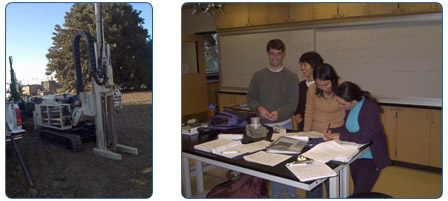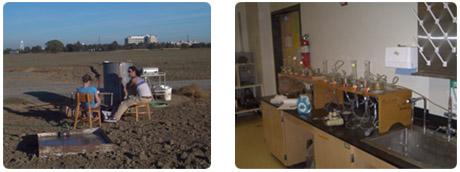
I currently teach 3 courses: Soil Physics (SSC 107), Irrigation Water Management (HYD 117), and Hydrologic modeling of the vadose zone (HYD 210). I am developing a new course on Environmental Sensing & Monitoring.
The introductory soil physics course (SSC 107) is team-taught with Dr. Rolston. In addition to 3 weekly lectures, the course includes a weekly laboratory and discussion section. The laboratory serves to demonstrate and apply the physical concepts that are presented in the lectures. In the discussion, we review new material, apply mathematics, solve past problem sets or exams, and generally discuss basic concepts and related issues that are put forward by the students. I have developed a SSC107 web page that makes available all course materials, including some home works and exams.

HYD117 Irrigation Water Management is the second of a series in irrigation courses (with HYD110). After a general introduction to irrigation principles. The course has developed into a case study course, ranging from water management policy issues in the State to the effects of deficit irrigation water on wine grapes and state-of-the-art irrigation technologies in green houses.
The hydrologic modeling course (HYD210) is my graduate course and is taught every other year. In this course, I prepare students to develop their own computer algorithms and prepare them to understand the concepts and mechanics of a computer model. The emphasis is on vadose zone modeling and includes water flow, contaminant transport and heat transport. In addition to the modeling, the students are challenged to have a solid understanding of the physical principles on which the models are based. Problems include the writing of computer codes to test their modeling skills, and also include a final project where they are encouraged to apply their acquired modeling knowledge to a graduate research project. As part of the course, I invite Dr. Jirka Simunek from the USDA Salinity Laboratory in Riverside, CA, to present a lecture and a computer session on the theory and application of HYDRUS-2D, which is among the state-of-the-art in terms of versatility, applicability and easiness-to-use among variably-saturated flow and transport codes. Students are required to complete 5 home work problem sets, and are give a final computer programming assignment.
I am developing a new upper-division course on ‘Environmental Sensing
& Monitoring’. The purpose of this multi-disciplinary course
would be to teach the latest methodologies of environmental and ecological
monitoring for a campus-wide student audience. Within the context of the
course, the environment is defined as a continuum of biological with physical/chemical
processes that combined sustains life. This course fits within the recently-defined
biocomplexity framework, emphasizing that individual components of an
environmental system only provide limited information about the behavior
of the systems themselves. The focus will be placed on measurements and
associated issues, and not on processes, assuming that these are taught
in disciplinary coursework.
I am developing a new upper-division course on ‘Environmental Sensing
& Monitoring’. The purpose of this multi-disciplinary course
would be to teach the latest methodologies of environmental and ecological
monitoring for a campus-wide student audience. Within the context of the
course, the environment is defined as a continuum of biological with physical/chemical
processes that combined sustains life. This course fits within the recently-defined
biocomplexity framework, emphasizing that individual components of an
environmental system only provide limited information about the behavior
of the systems themselves. The focus will be placed on measurements and
associated issues, and not on processes, assuming that these are taught
in disciplinary coursework.